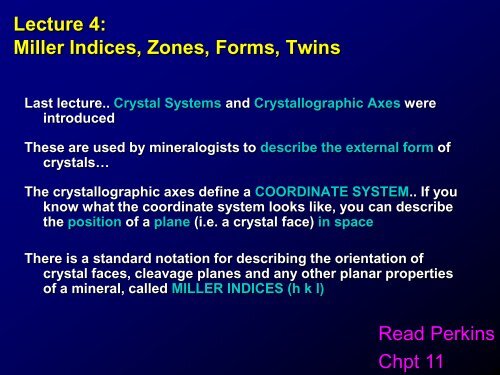Miller Indices
Miller Indices
Miller Indices
You also want an ePaper? Increase the reach of your titles
YUMPU automatically turns print PDFs into web optimized ePapers that Google loves.
Lecture 4:<br />
<strong>Miller</strong> <strong>Indices</strong>, Zones, Forms, Twins<br />
Last lecture.. Crystal Systems and Crystallographic Axes were<br />
introduced<br />
These are used by mineralogists to describe the external form of<br />
crystals…<br />
The crystallographic axes define a COORDINATE SYSTEM.. If you<br />
know what the coordinate system looks like, you can describe<br />
the position of a plane (i.e. a crystal face) in space<br />
There is a standard notation for describing the orientation of<br />
crystal faces, cleavage planes and any other planar properties<br />
of a mineral, called MILLER INDICES (h k l)<br />
Read Perkins<br />
Chpt 11
How to calculate a <strong>Miller</strong> Index:<br />
1. Find axial intercepts<br />
2. Invert axial intercepts (infinity => 0)<br />
3. Clear fractions<br />
Example:<br />
c<br />
1. Axial Intercepts:<br />
a=1, b=2, c=2<br />
2<br />
2<br />
b<br />
2. Invert intercepts:<br />
1/1, 1/2, 1/2<br />
1<br />
a<br />
3. Clear fractions:<br />
(2 1 1)
Example:<br />
c<br />
1. Axial Intercepts:<br />
1<br />
a=1, b=1, c=1<br />
2. Invert intercepts:<br />
1/1, 1/1, 1/1<br />
1 1<br />
a<br />
b<br />
3. Clear fractions:<br />
(1 1 1)<br />
c<br />
1. Axial Intercepts:<br />
a=1, b=1, c=infinity<br />
2. Invert intercepts:<br />
1/1, 1/1, 0<br />
a<br />
1 1<br />
b<br />
3. Clear fractions:<br />
(1 1 0)
2<br />
c<br />
-a<br />
1. Axial Intercepts:<br />
a=-1, b=1, c=2<br />
-1<br />
2. Invert intercepts:<br />
-1/1, 1/1, 1/2<br />
a<br />
1<br />
b<br />
3. Clear fractions:<br />
(-2 2 1)
Law of Rational <strong>Indices</strong> (“Hauy’s Law”): <strong>Miller</strong> indices<br />
can always be expressed by simple (small) whole numbers<br />
or zero<br />
Zone [u v w]: a direction defined by a set of crystal faces<br />
with parallel intersection edges; the zone axis is a line through the<br />
center of the crystal that is parallel to the lines of face<br />
intersections<br />
To calculate, choose 2 faces (h 1 k 1 l 1 ) and (h 2 k 2 l 2 )<br />
Example (100) and (10-1)<br />
Write h 1 k 1 l 1 h 1 k 1 l 1 1 0 0 1 0 0<br />
h 2 k 2 l 2 h 2 k 2 l 2 1 0-1 1 0 -1<br />
[uvw]=(k 1 l 2 -l 1 k 2 )(l 1 h 1 -h 1 l 2 )(h 1 k 2 -k 1 h 2 ) =<br />
(0-0), (0+1), (0-0) = [010]
FORM {h k l}: a group of crystal faces, related by<br />
symmetry<br />
So what? It means those faces all have the same chemical<br />
and physical properties, because they have the same<br />
underlying atomic structure<br />
Note: Don’t confuse FORM with HABIT<br />
HABIT = the external shape of a crystal specimen depends<br />
on symmetry, number and size of forms present, depends<br />
on growth conditions
The number of faces that belong to a FORM is determined<br />
by the symmetry of the point group (Ex. Figs 5.36, 5.37 in<br />
Klein)<br />
Ex. Bar 1<br />
Only have a center of symmetry, so form is just two<br />
parallel faces (“PINACOID”)<br />
Ex. 4/mbar32/m<br />
One face (1 1 1) will get reflected and rotated to form<br />
seven more faces (“OCTAHEDRON”)
More about forms…<br />
GENERAL FORMS: the faces in this form intersect the<br />
crystallographic axes at different lengths<br />
SPECIAL FORMS: all other forms; these faces are parallel<br />
or perpendicular to any of the symmetry elements in the<br />
crystal class
More about forms…<br />
CLOSED FORM: encloses space without the presence of<br />
other forms<br />
Ex. Dipyramid: 2 pyramids related by a mirror<br />
Ex. Cube: 6 square faces<br />
Ex. Octahedron: 8 equilateral triangle shaped faces<br />
(tetragonal dipyramid)<br />
OPEN FORM: does not completely enclose space<br />
Ex. Pedion: single face<br />
Ex. Pinacoid: two parallel faces<br />
There are 48 possible forms, which can occur in infinitely many sizes.
TWIN: a symmetrical intergrowth of two or more crystals of<br />
the same substance<br />
Twin element: new symmetry element that relates one part<br />
of the twin aggregate to the other part, they include.. TWIN<br />
PLANE, TWIN AXIS, TWIN CENTER<br />
Lots of kinds of twins, including:<br />
Contact Twins: two crystals appear to be touching; share a plane of<br />
atoms<br />
Penetration Twins: two crystal look like they’ve grown through each other;<br />
share a volume of atoms<br />
Multiple Twins: 3 or more parts of the crystal are twinned according to the<br />
same twin law; most common are polysynthetic twins
















